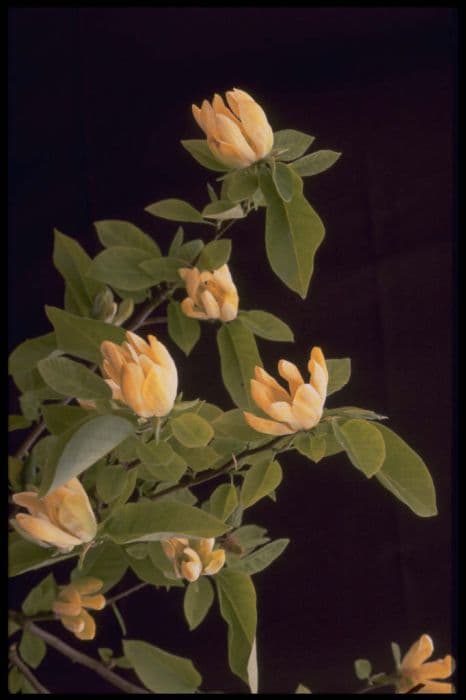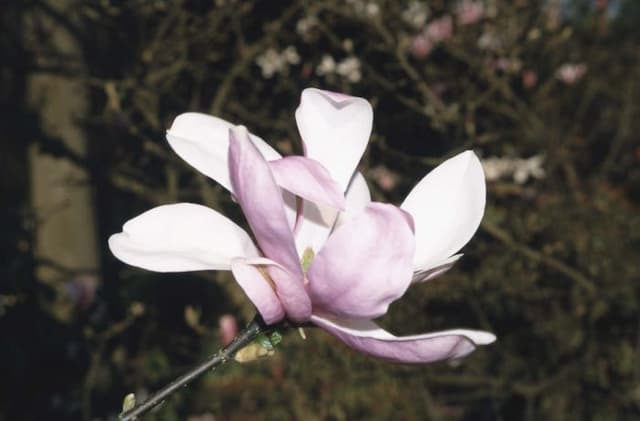Magnolia Caerhays Surprise Magnolia 'Caerhays Surprise'

ABOUT
The Magnolia 'Caerhays Surprise' is a striking flowering plant known for its showy, decorative blooms. The basic flower color is a striking pink which can appear quite vibrant. The petals are large and cup-shaped, unfurling gracefully as they open from their fuzzy, elongated buds. These blooms often carry a subtle fragrance that is both appealing and refreshing. Surrounding the flowers, the plant has a robust foliage consisting of glossy, green leaves that provide a lush background for the blossoms. The leaves are broad, with a smooth texture, and they have a leathery feel to them, which adds to the plant's overall sturdiness. The Magnolia 'Caerhays Surprise' has a tidy, attractive appearance that makes it a standout in any garden setting. Its blossoms are the focal point, bursting forth in the season with a display that is truly eye-catching.
About this plant
 Names
NamesFamily
Magnoliaceae.
Synonyms
Caerhays Surprise Magnolia, Magnolia 'Caerhays Surprise'.
Common names
Magnolia 'Caerhays Surprise'
 Toxicity
ToxicityTo humans
The Magnolia 'Caerhays Surprise', commonly known as Magnolia, is generally considered non-toxic to humans. There is no widespread evidence indicating that the Magnolia poses significant toxic risks when ingested. Therefore, accidental consumption of Magnolia plant parts, such as leaves or flowers, is unlikely to cause poisoning in humans. However, since individual reactions can vary, it is always prudent to exercise caution and keep all plants out of the reach of small children who might chew on them.
To pets
The Magnolia 'Caerhays Surprise', commonly known as Magnolia, is not typically toxic to pets such as dogs and cats. This means that if pets ingest parts of the Magnolia plant, they are unlikely to experience any significant toxic effects. While the ingestion of any non-food plant material can potentially cause mild stomach upset in some pets, symptoms of severe poisoning from Magnolias are not commonly reported. As with humans, individual reactions can vary, so it is still a good practice to monitor pets around plants and discourage them from chewing on non-edible materials.
 Characteristics
CharacteristicsLife cycle
Perennials
Foliage type
Deciduous
Color of leaves
Green
Flower color
Pink
Height
10-20 feet (3-6 meters)
Spread
6-15 feet (2-4.5 meters)
Plant type
Tree
Hardiness zones
7
Native area
Asia
Benefits
 General Benefits
General Benefits- Aesthetic Appeal: Magnolia 'Caerhays Surprise', commonly known as Magnolia, is prized for its large, showy flowers that can add dramatic beauty to gardens and landscapes.
- Spring Interest: The plant typically blooms in early spring, offering vibrant color when many other plants are still dormant.
- Attracts Pollinators: The large flowers provide a valuable nectar source for pollinators such as bees and butterflies in the garden.
- Low Maintenance: Magnolias are generally easy to care for once established, requiring minimal pruning and can thrive without excessive attention.
- Drought Tolerance: Once established, the plant can tolerate periods of dry conditions, making them suitable for various climates.
- Longevity: Magnolias can live for many years, providing long-lasting enjoyment and stability in a garden setting.
 Medical Properties
Medical PropertiesThis plant is not used for medical purposes.
 Air-purifying Qualities
Air-purifying QualitiesThis plant is not specifically known for air purifying qualities.
 Other Uses
Other Uses- Magnolia 'Caerhays Surprise', often known simply as Magnolia, can be used as a natural dye for fabrics, yielding various shades depending on the mordant used.
- The bark of the Magnolia tree can be processed into a rough textile material for creating eco-friendly crafts or rustic decorations.
- During the blooming season, petals can be collected and used to make scented potpourri, adding a fresh and natural fragrance to a room.
- Magnolia wood, being quite hard and heavy, can be used for making small-scale woodworking projects like jewelry boxes or picture frames.
- The leaves can be used to create artistic leaf rubbings for educational purposes or botanical art.
- Floral buds and petals can be encased in clear resin to create unique botanical jewelry such as pendants, earrings, or brooches.
- In the culinary arts, fallen Magnolia petals can be crystallized with sugar and used as elegant edible decorations for cakes and pastries.
- Magnolia seed pods, with their intriguing shapes, can be used in dry flower arrangements or as part of wreaths for natural home decor.
- The Magnolia's large, sturdy leaves are often used in floral arrangements as a backdrop to enhance the colors of other flowers.
- Children can use fallen Magnolia petals and leaves for educational nature crafts, like making collages or exploring plant structures.
Interesting Facts
 Feng Shui
Feng ShuiThe Magnolia is often associated with purity and nobility, and in Feng Shui, it can be used to attract positive energy or 'Chi' into a space. It is advisable to place the Magnolia in areas where you want to promote relaxation and tranquility, such as the living room or garden. Its blossoms are thought to bring a calming influence and can also symbolize perseverance and dignity, making it a good choice for a space where you seek personal growth and stability.
 Zodiac Sign Compitability
Zodiac Sign CompitabilityThe Magnolia is not used in astrology practice.
 Plant Symbolism
Plant Symbolism- Perseverance and Endurance: The Magnolia tree is known for its strength and ability to thrive for hundreds of years. This symbolism comes from the plant's early spring blooming, often before other plants and sometimes in the face of lingering frosts.
- Femininity and Beauty: The delicate and fragrant blossoms of the Magnolia tree are widely associated with feminine beauty and gentleness. The flower's association with nobility and dignity further reinforces this meaning.
- Grace and Nobility: Often found in noble and elegant gardens, Magnolias are a symbol of refined beauty and sophistication. 'Caerhays Surprise' with its stunning flowers often represents an unexpected beauty or a pleasant surprise in one's life.
- Purity and Innocence: The pure white color of some Magnolias lends itself to symbolize purity, innocence, and a clean slate, much like the first flower that emerges in the starkness of early spring.
 Water
WaterThe Magnolia 'Caerhays Surprise', commonly known as Caerhays Surprise Magnolia, requires consistent moisture, especially in its early years and during dry spells. It's best to water it deeply once a week, providing about 1.5 to 2 gallons of water for each watering session to ensure the soil remains moist but not waterlogged. During extended periods of drought, increase the watering frequency but be careful not to overwater. Reduce the amount of water in wintertime when the plant is dormant, but do not allow the soil to completely dry out.
 Light
LightCaerhays Surprise Magnolia flourishes best in full sun to partial shade. It is ideal to position the plant in a spot where it can receive at least four hours of direct sunlight daily, but it is also tolerant to some afternoon shade. Avoid locations where the plant would be in deep shade as this can affect its bloom and overall health.
 Temperature
TemperatureThe Caerhays Surprise Magnolia is hardy and can withstand temperatures as low as 0 degrees Fahrenheit, making it suitable for many climates. However, it thrives best in temperatures ranging between 60 and 70 degrees Fahrenheit. It is important to protect it from harsh winter winds and extreme temperature fluctuations that can damage the flower buds.
 Pruning
PruningPruning Caerhays Surprise Magnolia is usually done to shape the plant and remove any dead or damaged branches, enhancing the plant's overall health. The best time to prune is soon after the flowering season ends to avoid cutting off next year's buds. Pruning can be done annually, but it's often not necessary every year. Moderate pruning to maintain a desired shape or to remove unnecessary growth can be beneficial.
 Cleaning
CleaningAs needed
 Soil
SoilMagnolias prefer slightly acidic soil with a pH range of 5.0 to 6.5. For the best soil mix, combine equal parts loamy soil, well-rotted compost, and perlite or coarse sand to enhance drainage. This will provide a rich and well-draining foundation for the Magnolia 'Caerhays Surprise', encouraging healthy root growth and bloom production.
 Repotting
RepottingContainer-grown Magnolia 'Caerhays Surprise' should be repotted every 2 to 3 years or when they outgrow their pots. It's best done in late winter or early spring before the growing season starts, using a fresh acidic soil mix to refresh nutrients.
 Humidity & Misting
Humidity & MistingMagnolia 'Caerhays Surprise' thrives in average outdoor humidity levels and does not require special humidity adjustments. Aim for normal ambient humidity as found in many temperate climates where the magnolia is typically grown. Avoid placing in excessively dry or humid conditions, which can affect its health.
 Suitable locations
Suitable locationsIndoor
Ensure bright light, cool temps, and acidic soil.
Outdoor
Plant in partial sun, sheltered spot, and acidic soil.
Hardiness zone
7-9 USDA
 Life cycle
Life cycleThe life cycle of the Magnolia 'Caerhays Surprise' starts with seed germination, occurring in warm, moist soil conditions often in late spring or early summer. Once the seedling emerges, it enters a period of vegetative growth, developing a strong root system and woody stem. The juvenile plant then focuses on leaf production and establishing a robust framework for future blooming. As the magnolia matures into its adult phase, usually after several years, it begins its reproductive stage, producing large, fragrant pink blossoms typically in early spring before the foliage emerges. After pollination, the tree produces cone-like fruit with red seeds which, when mature, are dispersed to begin a new life cycle. The Magnolia 'Caerhays Surprise' can live for many decades, producing flowers annually during its reproductive phase.
 Propogation
PropogationPropogation time
Spring-Early Summer
Magnolia 'Caerhays Surprise', commonly known as Magnolia, is typically propagated by semi-hardwood cuttings. This method is most effective when carried out in summer, from mid-July to August, when new growth has begun to mature and harden. To propagate, a cutting of about 4 to 6 inches (10 to 15 centimeters) long is taken from a healthy branch, ensuring that it has at least two to three sets of leaves. The bottom leaves are removed, and the cutting is dipped in a rooting hormone to encourage root development. The prepared cutting is then inserted into a pot filled with a well-draining soil mixture, such as half peat and half perlite. The cutting should be kept under high humidity conditions with bottom heat of about 70 to 75 degrees Fahrenheit (21 to 24 degrees Celsius), and it's essential to maintain consistent moisture without overwatering until roots establish, which can take several weeks to a few months.



![Magnolia [Black Tulip]](/_next/image?url=https%3A%2F%2Fplants-admin.emdemapps.com%2Fimages%2Fplants%2F%2Fimages%2F604b590290fc7.png&w=640&q=75)


![Magnolia [Fairy Blush]](/_next/image?url=https%3A%2F%2Fplants-admin.emdemapps.com%2Fimages%2Fplants%2F%2Fimages%2F604b5a108e959.png&w=640&q=75)


